Michael Angelo Batio has been frequently described as the best shredder of all time.
He produced the first, and still best-selling, shred instructional video, and invented both his signature double guitar and MAB string dampeners. He’s performed in 45 countries around the world and even has his own record label – M.A.C.E. Music.
Michael has been playing guitar since age ten. Naturally left-handed, he plays the guitar righthanded, which at least partially explains his incredible ability to play two guitars at the same time. He’s played as many as four guitars at once; his performance playing his four-necked “quad” guitar with the band Nitro in their “Freight Train” video is one of the most over-the-top performances of all time.
His style developed out of the early weakness of his picking hand. He worked for years as a teen to master alternate picking and two-hand tapping techniques. Michael explains, “I’m a firm believer in working on your deficiencies. Once you master a technique that gives you trouble, other areas of your playing improve dramatically.”
Now one of the fastest shredders on the planet, Michael is known for his MAB Over-Under Technique, where he flips his hand over and under the guitar neck, approaching the strings from above and below at incredible speed – all without missing a note.
I first saw Michael Angelo Batio in 1987 at a Gibson Guitar clinic. We were all anxious to meet him and see him perform with his double guitar. He explained how it was constructed and then he played the living hell out of it. I couldn’t believe it was humanly possible to pull it off, but he did and still does. I’ve been fortunate enough to see him perform a number of times since, and even traded licks with him in 2007 onstage at a Dean Guitar clinic. Since then, Michael and I have become friends and I’ve found he’s a very humble, yet extremely driven guy.
 Michael’s distinct tone comes primarily from his fingers, but he does use specific guitars, amps and effects to achieve his signature sound. He’s known for using Gibson, Charvel, Ritz and Dean Guitars and BOSS overdrive pedals, all run into Marshall amplifiers. It’s smooth, fiercely overdriven and punchy synth-esque sound, as heard during Michael’s earlier years, is actually a combination of the BOSS SD-1 pedal into modded Marshall JCM800 amps set at medium gain and a slightly high volume. In the mid-nineties, Michael acquired an original Ibanez TS- 9, which he used on the album, Hands Without Shadows.
Michael’s distinct tone comes primarily from his fingers, but he does use specific guitars, amps and effects to achieve his signature sound. He’s known for using Gibson, Charvel, Ritz and Dean Guitars and BOSS overdrive pedals, all run into Marshall amplifiers. It’s smooth, fiercely overdriven and punchy synth-esque sound, as heard during Michael’s earlier years, is actually a combination of the BOSS SD-1 pedal into modded Marshall JCM800 amps set at medium gain and a slightly high volume. In the mid-nineties, Michael acquired an original Ibanez TS- 9, which he used on the album, Hands Without Shadows.
He uses custom designed DiMarzio pickups – a PAF Pro and/or PAF in the neck position and a Super Distortion and/or Double Whammy in the bridge position – along with EMGs (in his Dean signature series guitars) and Seymour Duncan JBs (in some of his double guitars). For amps, Michael now prefers to use the new line of Marshall Valve amplifiers, specifically the JCM2000 DSL, along with Mesa Boogie Dual Rectifiers for his rhythm parts.
In 2007, Michael, in conjunction with T. Rex Engineering, launched an overdrive pedal designed especially for him. The pedal is simply called the Michael Angelo Batio Overdrive, and features more gain to satisfy Michael’s taste for heavily overdriven sounds.
This month Michael has been cool enough to show off five of his favorite exercises – double guitar not required.





He produced the first, and still best-selling, shred instructional video, and invented both his signature double guitar and MAB string dampeners. He’s performed in 45 countries around the world and even has his own record label – M.A.C.E. Music.
Michael has been playing guitar since age ten. Naturally left-handed, he plays the guitar righthanded, which at least partially explains his incredible ability to play two guitars at the same time. He’s played as many as four guitars at once; his performance playing his four-necked “quad” guitar with the band Nitro in their “Freight Train” video is one of the most over-the-top performances of all time.
His style developed out of the early weakness of his picking hand. He worked for years as a teen to master alternate picking and two-hand tapping techniques. Michael explains, “I’m a firm believer in working on your deficiencies. Once you master a technique that gives you trouble, other areas of your playing improve dramatically.”
Now one of the fastest shredders on the planet, Michael is known for his MAB Over-Under Technique, where he flips his hand over and under the guitar neck, approaching the strings from above and below at incredible speed – all without missing a note.
I first saw Michael Angelo Batio in 1987 at a Gibson Guitar clinic. We were all anxious to meet him and see him perform with his double guitar. He explained how it was constructed and then he played the living hell out of it. I couldn’t believe it was humanly possible to pull it off, but he did and still does. I’ve been fortunate enough to see him perform a number of times since, and even traded licks with him in 2007 onstage at a Dean Guitar clinic. Since then, Michael and I have become friends and I’ve found he’s a very humble, yet extremely driven guy.
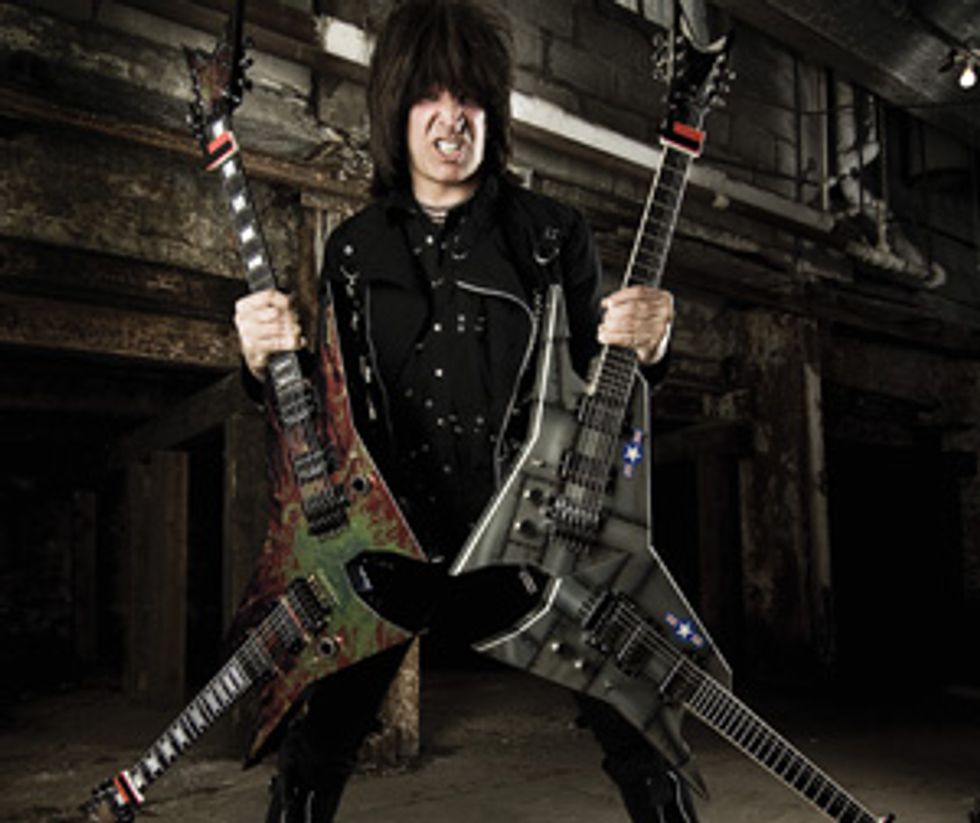 Michael’s distinct tone comes primarily from his fingers, but he does use specific guitars, amps and effects to achieve his signature sound. He’s known for using Gibson, Charvel, Ritz and Dean Guitars and BOSS overdrive pedals, all run into Marshall amplifiers. It’s smooth, fiercely overdriven and punchy synth-esque sound, as heard during Michael’s earlier years, is actually a combination of the BOSS SD-1 pedal into modded Marshall JCM800 amps set at medium gain and a slightly high volume. In the mid-nineties, Michael acquired an original Ibanez TS- 9, which he used on the album, Hands Without Shadows.
Michael’s distinct tone comes primarily from his fingers, but he does use specific guitars, amps and effects to achieve his signature sound. He’s known for using Gibson, Charvel, Ritz and Dean Guitars and BOSS overdrive pedals, all run into Marshall amplifiers. It’s smooth, fiercely overdriven and punchy synth-esque sound, as heard during Michael’s earlier years, is actually a combination of the BOSS SD-1 pedal into modded Marshall JCM800 amps set at medium gain and a slightly high volume. In the mid-nineties, Michael acquired an original Ibanez TS- 9, which he used on the album, Hands Without Shadows.He uses custom designed DiMarzio pickups – a PAF Pro and/or PAF in the neck position and a Super Distortion and/or Double Whammy in the bridge position – along with EMGs (in his Dean signature series guitars) and Seymour Duncan JBs (in some of his double guitars). For amps, Michael now prefers to use the new line of Marshall Valve amplifiers, specifically the JCM2000 DSL, along with Mesa Boogie Dual Rectifiers for his rhythm parts.
In 2007, Michael, in conjunction with T. Rex Engineering, launched an overdrive pedal designed especially for him. The pedal is simply called the Michael Angelo Batio Overdrive, and features more gain to satisfy Michael’s taste for heavily overdriven sounds.
This month Michael has been cool enough to show off five of his favorite exercises – double guitar not required.
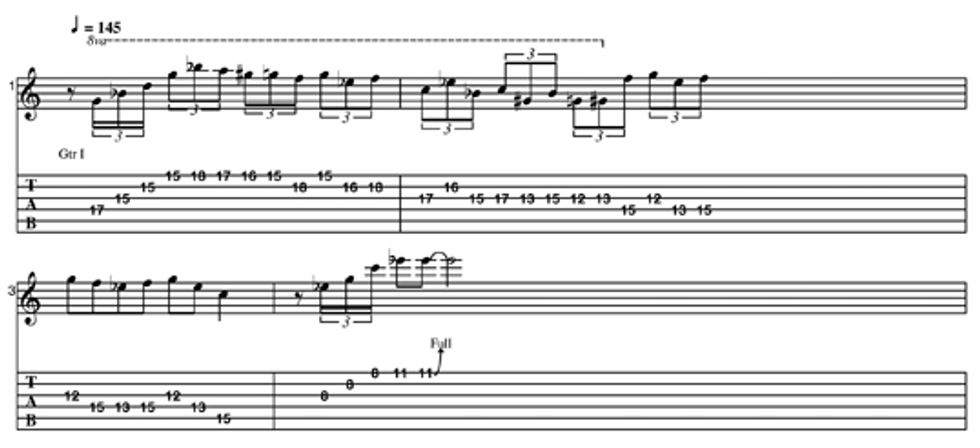
| Exercise 1 This example features 16th note triplets diatonically ascending and “back tracking” up the fretboard. For me, the key is to take the riffs and go in unexpected directions rather than just ascending or descending in a predictable way. |
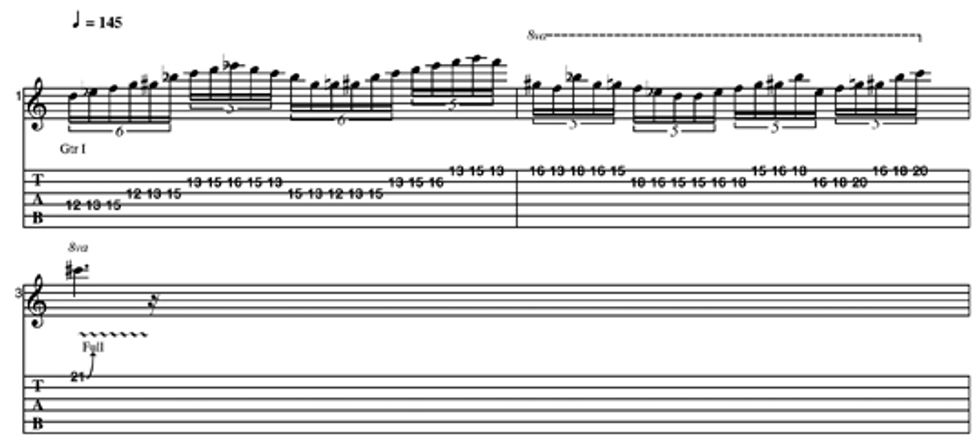
| Exercise 2 Exercise 2 is an example of one of my riffs in the key of Bb. Again, I like to use chromatic passing tones, but in a rock and metal guitar context. These exercises are good examples of how I take what could be standard melodic choices and twist and turn the notes around to create my own style. |
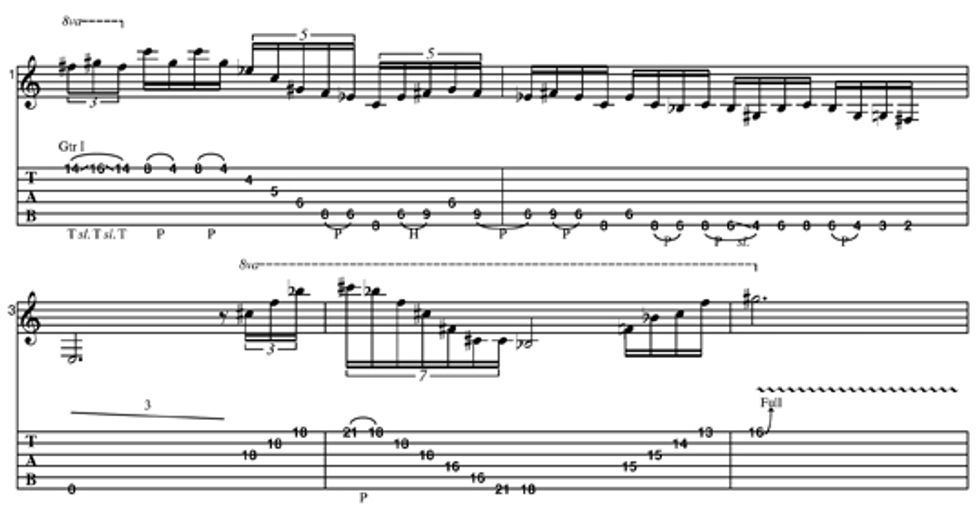
| Exercise 3 Here we look at using asymmetrical note groupings – it’s one thing to use triplets and another to use groups of odd numbers of notes in a count or beat. This is a good example of how I use rhythm and melody to create interesting lead guitar lines that are not stock or standard. |
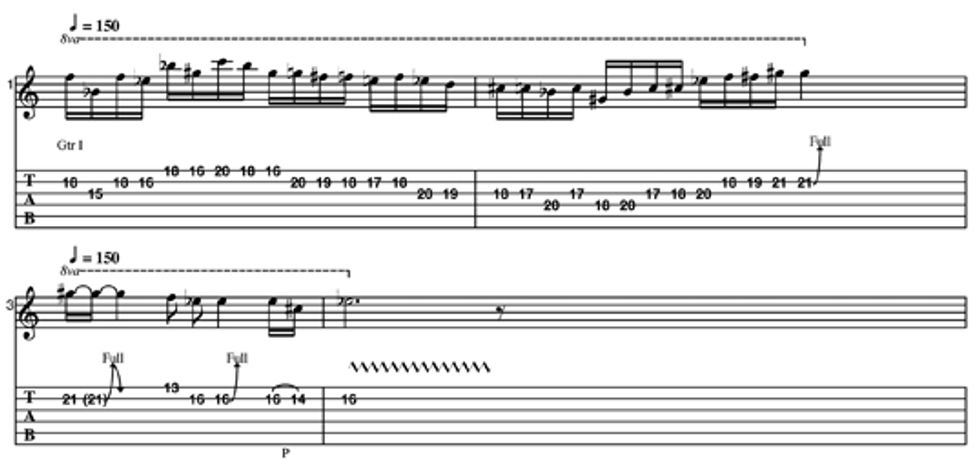
| Exercise 4 This exercise makes up a complete section from my song, “The Finish Line.” It is in the key of C major, and again utilizes a lot of passing tones. I made this in the style of Charlie Christian, who is one of my inspirations as a guitar player. When I perform it, I add a dotted rhythm to give the notes a “swing” feel. |
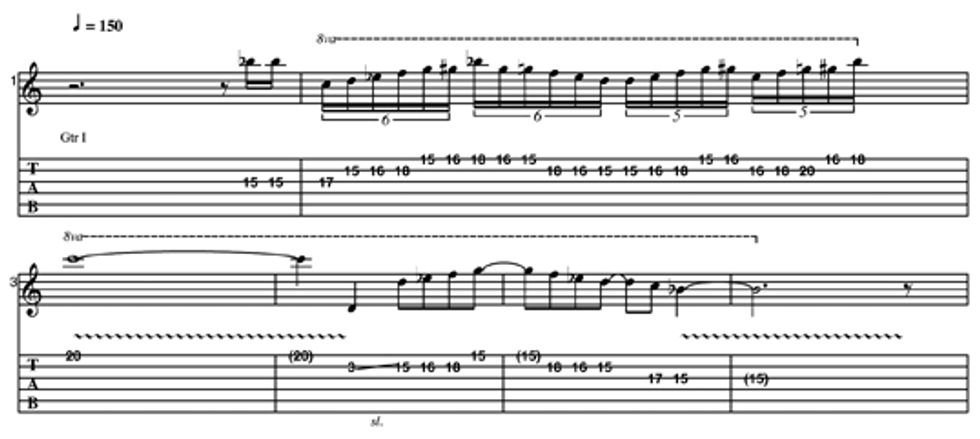
| Exercise 5 This riff is in the key of G major and is from the studio version of my song, “No Boundaries.” I use this kind of pattern because I like the flow of the notes; instead of just straight ascending or descending, I use a technique that I call “back tracking,” where I actually use descending passages of notes while ascending up the fretboard and vice versa. |





![Rig Rundown: Russian Circles’ Mike Sullivan [2025]](https://www.premierguitar.com/media-library/youtube.jpg?id=62303631&width=1245&height=700&quality=70&coordinates=0%2C0%2C0%2C0)






















![Rig Rundown: AFI [2025]](https://www.premierguitar.com/media-library/youtube.jpg?id=62064741&width=1245&height=700&quality=70&coordinates=0%2C0%2C0%2C0)




















 Zach loves his Sovtek Mig 60 head, which he plays through a cab he built himself at a pipe-organ shop in Denver. Every glue joint is lined with thin leather for maximum air tightness, and it’s stocked with Celestion G12M Greenback speakers.
Zach loves his Sovtek Mig 60 head, which he plays through a cab he built himself at a pipe-organ shop in Denver. Every glue joint is lined with thin leather for maximum air tightness, and it’s stocked with Celestion G12M Greenback speakers.











